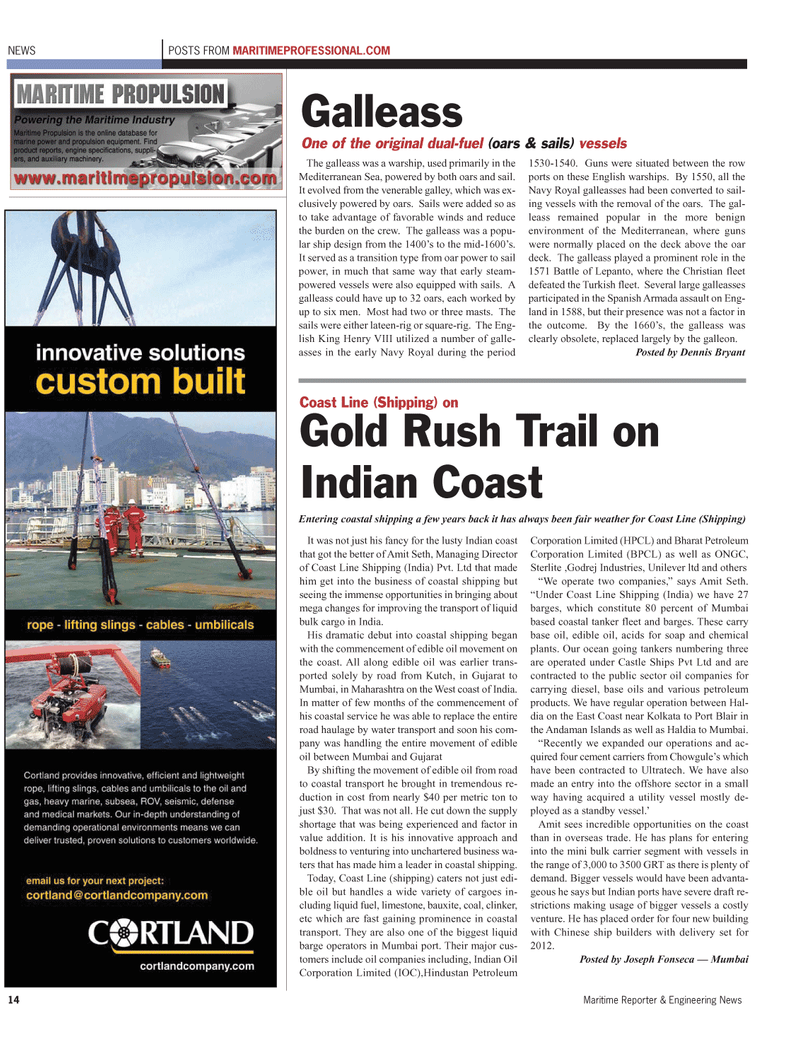
Page 14: of Maritime Reporter Magazine (April 2011)
Offshore Annual
Read this page in Pdf, Flash or Html5 edition of April 2011 Maritime Reporter Magazine
14 Maritime Reporter & Engineering News
NEWS POSTS FROM MARITIMEPROFESSIONAL.COM
The galleass was a warship, used primarily in the
Mediterranean Sea, powered by both oars and sail.
It evolved from the venerable galley, which was ex- clusively powered by oars. Sails were added so as to take advantage of favorable winds and reduce the burden on the crew. The galleass was a popu- lar ship design from the 1400’s to the mid-1600’s.
It served as a transition type from oar power to sail power, in much that same way that early steam- powered vessels were also equipped with sails. A galleass could have up to 32 oars, each worked by up to six men. Most had two or three masts. The sails were either lateen-rig or square-rig. The Eng- lish King Henry VIII utilized a number of galle- asses in the early Navy Royal during the period 1530-1540. Guns were situated between the row ports on these English warships. By 1550, all the
Navy Royal galleasses had been converted to sail- ing vessels with the removal of the oars. The gal- leass remained popular in the more benign environment of the Mediterranean, where guns were normally placed on the deck above the oar deck. The galleass played a prominent role in the 1571 Battle of Lepanto, where the Christian fleet defeated the Turkish fleet. Several large galleasses participated in the Spanish Armada assault on Eng- land in 1588, but their presence was not a factor in the outcome. By the 1660’s, the galleass was clearly obsolete, replaced largely by the galleon.
Posted by Dennis Bryant
Galleass
One of the original dual-fuel (oars & sails) vessels
It was not just his fancy for the lusty Indian coast that got the better of Amit Seth, Managing Director of Coast Line Shipping (India) Pvt. Ltd that made him get into the business of coastal shipping but seeing the immense opportunities in bringing about mega changes for improving the transport of liquid bulk cargo in India.
His dramatic debut into coastal shipping began with the commencement of edible oil movement on the coast. All along edible oil was earlier trans- ported solely by road from Kutch, in Gujarat to
Mumbai, in Maharashtra on the West coast of India.
In matter of few months of the commencement of his coastal service he was able to replace the entire road haulage by water transport and soon his com- pany was handling the entire movement of edible oil between Mumbai and Gujarat
By shifting the movement of edible oil from road to coastal transport he brought in tremendous re- duction in cost from nearly $40 per metric ton to just $30. That was not all. He cut down the supply shortage that was being experienced and factor in value addition. It is his innovative approach and boldness to venturing into unchartered business wa- ters that has made him a leader in coastal shipping.
Today, Coast Line (shipping) caters not just edi- ble oil but handles a wide variety of cargoes in- cluding liquid fuel, limestone, bauxite, coal, clinker, etc which are fast gaining prominence in coastal transport. They are also one of the biggest liquid barge operators in Mumbai port. Their major cus- tomers include oil companies including, Indian Oil
Corporation Limited (IOC),Hindustan Petroleum
Corporation Limited (HPCL) and Bharat Petroleum
Corporation Limited (BPCL) as well as ONGC,
Sterlite ,Godrej Industries, Unilever ltd and others “We operate two companies,” says Amit Seth. “Under Coast Line Shipping (India) we have 27 barges, which constitute 80 percent of Mumbai based coastal tanker fleet and barges. These carry base oil, edible oil, acids for soap and chemical plants. Our ocean going tankers numbering three are operated under Castle Ships Pvt Ltd and are contracted to the public sector oil companies for carrying diesel, base oils and various petroleum products. We have regular operation between Hal- dia on the East Coast near Kolkata to Port Blair in the Andaman Islands as well as Haldia to Mumbai. “Recently we expanded our operations and ac- quired four cement carriers from Chowgule’s which have been contracted to Ultratech. We have also made an entry into the offshore sector in a small way having acquired a utility vessel mostly de- ployed as a standby vessel.’
Amit sees incredible opportunities on the coast than in overseas trade. He has plans for entering into the mini bulk carrier segment with vessels in the range of 3,000 to 3500 GRT as there is plenty of demand. Bigger vessels would have been advanta- geous he says but Indian ports have severe draft re- strictions making usage of bigger vessels a costly venture. He has placed order for four new building with Chinese ship builders with delivery set for 2012.
Posted by Joseph Fonseca — Mumbai
Coast Line (Shipping) on
Gold Rush Trail on
Indian Coast
Entering coastal shipping a few years back it has always been fair weather for Coast Line (Shipping)

 13
13

 15
15
